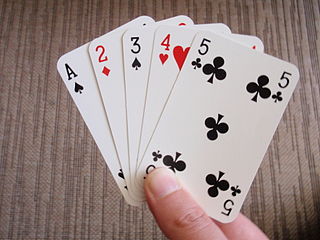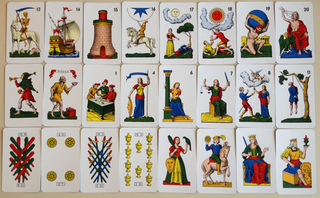
A card game is any game that uses playing cards as the primary device with which the game is played, whether the cards are of a traditional design or specifically created for the game (proprietary). Countless card games exist, including families of related games. A small number of card games played with traditional decks have formally standardized rules with international tournaments being held, but most are folk games whose rules may vary by region, culture, location or from circle to circle.

A playing card is a piece of specially prepared card stock, heavy paper, thin cardboard, plastic-coated paper, cotton-paper blend, or thin plastic that is marked with distinguishing motifs. Often the front (face) and back of each card has a finish to make handling easier. They are most commonly used for playing card games, and are also used in magic tricks, cardistry, card throwing, and card houses; cards may also be collected. Playing cards are typically palm-sized for convenient handling, and usually are sold together in a set as a deck of cards or pack of cards.

Tarot is a pack of playing cards, used from at least the mid-15th century in various parts of Europe to play card games such as Tarocchini. From their Italian roots, tarot-playing cards spread to most of Europe, evolving into a family of games that includes German Grosstarok and modern games such as French Tarot and Austrian Königrufen. In the late 18th century French occultists made elaborate, but unsubstantiated, claims about their history and meaning, leading to the emergence of custom decks for use in divination via tarot card reading and cartomancy. Thus, there are two distinct types of tarot packs in circulation: those used for card games and those used for divination. However, some older patterns, such as the Tarot de Marseille, originally intended for playing card games, are occasionally used for cartomancy.

In playing cards, a suit is one of the categories into which the cards of a deck are divided. Most often, each card bears one of several pips (symbols) showing to which suit it belongs; the suit may alternatively or additionally be indicated by the color printed on the card. The rank for each card is determined by the number of pips on it, except on face cards. Ranking indicates which cards within a suit are better, higher or more valuable than others, whereas there is no order between the suits unless defined in the rules of a specific card game. In most decks, there is exactly one card of any given rank in any given suit. A deck may include special cards that belong to no suit, often called jokers.
Guardian usually refers to:

A Jack or Knave, in some games referred to as a Bower, in Tarot card games as a Valet, is a playing card which, in traditional French and English decks, pictures a man in the traditional or historic aristocratic or courtier dress, generally associated with Europe of the 16th or 17th century. The usual rank of a jack is between the ten and the queen.
Death is the irreversible cessation of all biological functions that sustain an organism.
Magician or The Magician may refer to:

Playing cards have been in Italy since the late 14th century. Until the mid 19th century, Italy was composed of many smaller independent states which led to the development of various regional patterns of playing cards; "Italian suited cards" normally only refer to cards originating from northeastern Italy around the former Republic of Venice, which are largely confined to northern Italy, parts of Switzerland, Dalmatia and southern Montenegro. Other parts of Italy traditionally use traditional local variants of Spanish suits, French suits or German suits.
A witch is a practitioner of witchcraft.
A sword is a cutting and/or thrusting weapon.
Following is a 1998 British neo-noir film directed by Christopher Nolan.

The Swiss Tarot deck is a 78-card deck used for the tarot card games Troccas and Troggu. It is also sometimes called the JJ Tarot due to the replacement of the usual second and fifth trumps with cards depicting Juno and Jupiter, or as 1JJ Tarot in reference to the catalog number of a common release of the deck by A.G. Müller.

Tarot games are card games played with tarot packs designed for card play and which have a permanent trump suit alongside the usual four card suits. The games and packs which English-speakers call by the French name tarot are called tarocchi in the original Italian, Tarock in German and similar words in other languages.

The Tarocco Siciliano is a tarot deck found in Sicily and is used to play Sicilian tarocchi. It is one of the three traditional Latin-suited tarot decks still used for games in Italy, the others being the more prevalent Tarocco Piemontese and the Tarocco Bolognese. The deck was heavily influenced by the Tarocco Bolognese and the Minchiate. It is also the only surviving tarot deck to use the Portuguese variation of the Latin suits of cups, coins, swords, and clubs which died out in the late 19th and early 20th centuries.

Playing cards were most likely invented in China during the Southern Song dynasty (1127–1279). They were certainly in existence by the Mongol Yuan dynasty (1271-1368). Chinese use the word pái (牌), meaning "plaque", to refer to both playing cards and tiles. Many early sources are ambiguous, and do not specifically refer to paper pái (cards) or bone pái (tiles); but there is no difference in play between these, as either serves to hide one face from the other players with identical backs.

The suit of coins is one of the four card suits used in Latin-suited playing cards alongside swords, cups and batons. These suits are used in Spanish, Italian and some tarot card packs. This suit has maintained its original identity from Chinese money-suited cards. Symbol on Italian pattern cards: Symbol on Spanish pattern cards: Symbol on French aluette cards:










